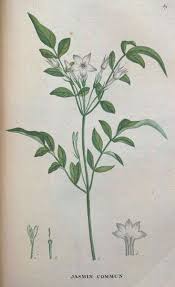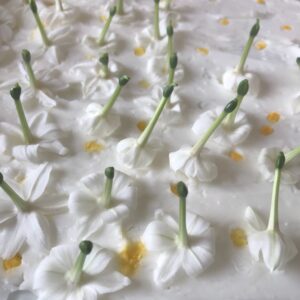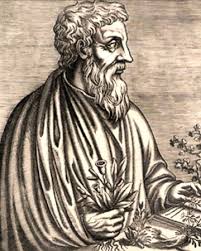Jasmine is a semi-evergreen shrub, which can grow up to 10 metres in height. In a cool climate it will shed its leaves once a year. It produces abundant clusters of white, star-shaped flowers whose fragrance intensifies at dusk. The plant is native to China, India and Persia where hundreds of varieties are known.

The most popular species used in aromatherapy and perfumery are Spanish jasmine (Jasminum grandiflorum), originally from the Himalayas, and common jasmine (Jasminum officinale). Both species are grown commercially in Mediterranean regions, Egypt, Morocco, India and China. The exquisite Arabian jasmine (Jasminum sambac) is grown mainly in Syria and the mountains of northern India.
To the French perfumer, jasmine is known simply as la fleur (the flower) and is an ingredient of almost every fine perfume. Indeed, jasmine (for more commonly its various synthetic counterparts) is found in 83% of women's fragrances and in about 22% of men's fragrances. In India the plant is called 'moonlight of the grove', for the flowers release their fragrance at night. By mid-morning the intensity of fragrance has all but gone, so the flowers are always gathered at dawn. As the blooms are highly susceptible to fermentation, they are rushed to the distilleries for immediate processing.
Capturing the Essence

Enfleurage, the traditional method of extraction, is a labour-intensive process whereby the scent of the flowers is absorbed by cold purified fat and then washed out with alcohol to produce an absolute ex pommade. Almost all the jasmine 'oil' available today is extracted with the aid of volatile solvents such as hexane and petroleum ether.
The resulting product, called an absolute, is not a pure essential oil as it contains additional (water-soluble) constituents and minute traces of the solvent used in the extraction process. The amount of solvent remaining in the absolute is negligible, and therefore almost certainly harmless to health. However, some aromatherapists argue that the use of petrochemical solvents runs counter to the philosophy of aromatherapy, which prides itself on being entirely 'natural'. However, there is no denying that the fragrance of solvent-extracted absolute is truly superb, being almost identical to that of the living plant and it therefore has remarkable mood-enhancing potential.
With the exception of steam-distilled rose otto and neroli, the majority of flower absolutes (especially the rare enfleurage absolutes) are more expensive than essential oils. This is not only due to the painstaking extraction process, but because most flowers yield such a tiny amount of oil. Eight thousand jasmine flowers, for example, produce only 1g of absolute.
Aphrodisiac Properties
Jasmine absolute is a reddish brown, viscous liquid with a rich, warm, floral scent and a musky undertone. The effect of its aroma is generally perceived as warming and intoxicating, and reputedly aphrodisiac. Its erogenic quality (the perfumery term for 'sexual attractant') has been attributed to the presence of indole - one of the repulsive smells of the rear end of animals and their waste products. When present in tiny quantities and in balance with the other constituents of the natural scent of jasmine, it takes on a pleasantly musky character that harmonises with body scent, enhancing sensuality.
The Arabic name for jasmine is ysmyn, while the Persian is jasemin and the Chinese yeh-lsi-ming. In India there are many ancient portrayals of lovers bathed in moonlight and surrounded by jasmine. In Hindu folklore the god of love, Kama, anointed the tips of his arrows of desire with jasmine oil before piercing hearts.
In the first century AD the Greek physician Dioscorides reported that the men and women of Persia perfumed their bodies with jasmine oil before making love. Jasmine, along with hyacinth an rose, was frequently alluded to in Sufi poetry as a metaphor for love and spiritual longing.

Under Christianity, its allure became that of 'divine hope' and it was dedicated to the Virgin Mary, the star-shaped flowers symbolising heavenly felicity.
The Herbal Remedy
In Ayurvedic medicine, jasmine flowers are regarded as an elixir for women. Taken as a tea, jasmine calms the nerves, relieves period pain, stems menstruation and dispels tension headaches. Applied locally, the cooled tea is said to clear mild cases of thrush. In China, the flowers are used to treat dysentery and hepatitis, and to flavour black tea.
In British herbalism, jasmine's astringent properties are used to soothe inflamed eyes and skin, and in gargles to relieve sore throats. According to the herbalist Nicholas Culpeper, jasmine tea eases labour pain and generally facilitates birth.
Aromatherapy Uses
Jasmine's main use is for emotional healing. Many people find the aroma uplifting, even euphoric; others find it deeply relaxing. Aromatherapists believe that people respond differently according to their physical and emotional needs. If the aroma is liked, its warming, sensual fragrance can help restore loss of libido caused by anxiety or mild depression. It is also used to relieve a range of emotional problems associated with a stressful lifestyle, grief or worry. Many women have found it helpful for post-natal depression - although it is best avoided while breastfeeding.
Jasmine absolute plays a significant role in women's healthcare. In the bath, as a massage oil, or simply inhaled, it can help relieve PMS symptoms, menopausal problems, period pain and ease the course of childbirth. It can be used in baths and steam inhalations for catarrhal coughs and laryngitis, and in massage blends for muscular spasm and strains, but many less expensive oils are equally beneficial. Jasmine is also a lovely oil to use in skincare, particularly for dingy 'city' skin, whether it is dry, greasy, combination or normal.